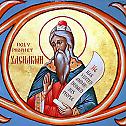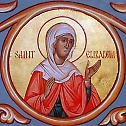Culture
Sts Joachim and Anna, parents of Blessed Mary (Theotokos)
22. September 2018 - 14:07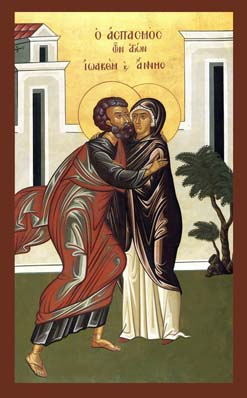 So much attention is paid by Christians to the Blessed Virgin Mary, the Theotokos, sanctified in every conceivable way, that there is a tendency to overlook her parents. Commemorated the day after the commemoration of their daughter, who is remembered on other days as well, Joachim and Anna were the parents of a flesh-and-blood human being they called Mary and, therefore, the grandparents of a flesh-and-blood human being, in form at least, who died to save the world.
So much attention is paid by Christians to the Blessed Virgin Mary, the Theotokos, sanctified in every conceivable way, that there is a tendency to overlook her parents. Commemorated the day after the commemoration of their daughter, who is remembered on other days as well, Joachim and Anna were the parents of a flesh-and-blood human being they called Mary and, therefore, the grandparents of a flesh-and-blood human being, in form at least, who died to save the world.
Considered in this light, this couple is appreciated most by the grandfathers and grandmothers of the world.
The spiritual beauty of St Anna is expressed in the Bible, equalled by that of her devoted husband, the too lightly regarded Joachim. Since there is no greater part of the divine plan of the universe than motherhood, it follows that St. Anna is given individual honour with an observance of a feast day in her name on July 26. This in no way diminishes the image of her husband St Joachim.
Nativity of the Theotokos
21. September 2018 - 13:16 Commemorated September 8
Commemorated September 8
The establishment of four major feast days to honour the Blessed Virgin Mary took place in the days of the apostolic era and have a significance in the Greek Orthodox Church which has remained unaltered through nearly twenty centuries of Christianity. The mother' of the Son of God is honoured on March 25, the day of Annunciation when the Archangel Gabriel told Mary she was to become the mother of Jesus Christ; the Repose of the blessed Virgin Mary on August 15; on November 21, the Entrance of the Blessed Theotokos to the Temple; and on February 2 when the Mother of God brought the infant Jesus to the temple for presentation forty days after His birth.
A fifth day of commemoration is celebrated on September 8, honouring the Virgin Mary on the day of her birth. This day was set aside by the Orthodox Church in the early first century, but not observed until the eighth century when Pope Sergios saw fit to join with the Orthodox during his reign which extended from A.D. 687 to 701. All of Christendom agreed on the date that the Virgin Mary was born, but for some reason the date was not an official feast day in the Roman sector for more than a third of the length of existence of the Christian Church.
Sts. Zacharias the Prophet and Elizabeth the Righteous, the Parents of the Precious Forerunner
18. September 2018 - 15:04The Holy Prophet Zachariah and the Righteous Elizabeth were the parents of the holy Prophet, Forerunner and Baptist of the Lord, John. They were descended from the lineage of Aaron: St Zachariah, son of Barach, was a priest in the Jerusalem Temple, and St Elizabeth was the sister of St Anna, the mother of the Most Holy Theotokos. The righteous spouses, walking in all the commandments of the Lord (Luke 1:6), suffered barrenness, which in those times was considered a punishment from God.
Welcoming the Christ Child
14. September 2018 - 10:57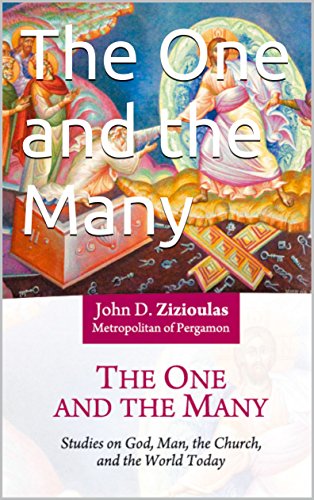 Journey through the Old Testament with 40 wonderfully illustrated Bible readings, one for each day of the Nativity Lent. These short, beloved stories from Scripture include questions and answers to encourage family discussion, and can be used any of time of year, to assist parents in their efforts to bring the Holy Orthodox Faith to life in their homes, increasing understanding and inspiring love for Christ and His Church. Old Testament events and prophecies—many of which are shown to point the way to the birth of the Christ Child—together with New Testament events leading up to and including Christ’s Nativity, all serve to help Orthodox families enter more deeply into the spirit of the Nativity Fast, and to celebrate the feast of Christmas with greater understanding and inspiration.
Journey through the Old Testament with 40 wonderfully illustrated Bible readings, one for each day of the Nativity Lent. These short, beloved stories from Scripture include questions and answers to encourage family discussion, and can be used any of time of year, to assist parents in their efforts to bring the Holy Orthodox Faith to life in their homes, increasing understanding and inspiring love for Christ and His Church. Old Testament events and prophecies—many of which are shown to point the way to the birth of the Christ Child—together with New Testament events leading up to and including Christ’s Nativity, all serve to help Orthodox families enter more deeply into the spirit of the Nativity Fast, and to celebrate the feast of Christmas with greater understanding and inspiration.
Elissa Bjeletich is a wife and mother, raising five daughters and working in the Sunday school at Transfiguration Greek Orthodox Church in Austin, Texas
In the Mirror: A Collection of Iconographic Essays and Illustrations by Fr. Stamatis Skliris
14. September 2018 - 10:55 This collection of iconographic essays and illustrations by Fr. Stamatis Skliris is an anthology of his articles, translated into English, in which he combines adherence to the teachings of the Church Fathers with a vibrant expression of faith through the experience of Christ in the Church. The book is adorned with more than 200 of his striking icons and illustrations. Fr Stamatis is one example of an synthetical, Neopatristic approach in the arts. Although he basically employs a dark Byzantine under-painting, adding to it light “accents” (illuminations), he still plays with colors in such an impressionist manner that his work gains a “non-determinism of color.” Stamatis articulates a dialogue with modern art by evaluating the brush strokes of Van Gogh Cézanne, Monet’s colors, Matisse’s forms, Picasso’s Cubism, and Post-modernism. Stamatis reminds us of the times when Church had the ability to shape the culture; yet, he does not copies ready-made solutions from the iconographic past but researches everything anew; a strong experimental sense is at his disposal, and he combines strictly traditional elements with those that are modern; e.g., The Mighty Protectress (Theotokos) is strongly traditional, but Christ has the movement, the colors, and brush deposits of modern, expressionist art.
This collection of iconographic essays and illustrations by Fr. Stamatis Skliris is an anthology of his articles, translated into English, in which he combines adherence to the teachings of the Church Fathers with a vibrant expression of faith through the experience of Christ in the Church. The book is adorned with more than 200 of his striking icons and illustrations. Fr Stamatis is one example of an synthetical, Neopatristic approach in the arts. Although he basically employs a dark Byzantine under-painting, adding to it light “accents” (illuminations), he still plays with colors in such an impressionist manner that his work gains a “non-determinism of color.” Stamatis articulates a dialogue with modern art by evaluating the brush strokes of Van Gogh Cézanne, Monet’s colors, Matisse’s forms, Picasso’s Cubism, and Post-modernism. Stamatis reminds us of the times when Church had the ability to shape the culture; yet, he does not copies ready-made solutions from the iconographic past but researches everything anew; a strong experimental sense is at his disposal, and he combines strictly traditional elements with those that are modern; e.g., The Mighty Protectress (Theotokos) is strongly traditional, but Christ has the movement, the colors, and brush deposits of modern, expressionist art.
The Beheading of the Holy Glorious Prophet, Forerunner, and Baptist John
11. September 2018 - 14:13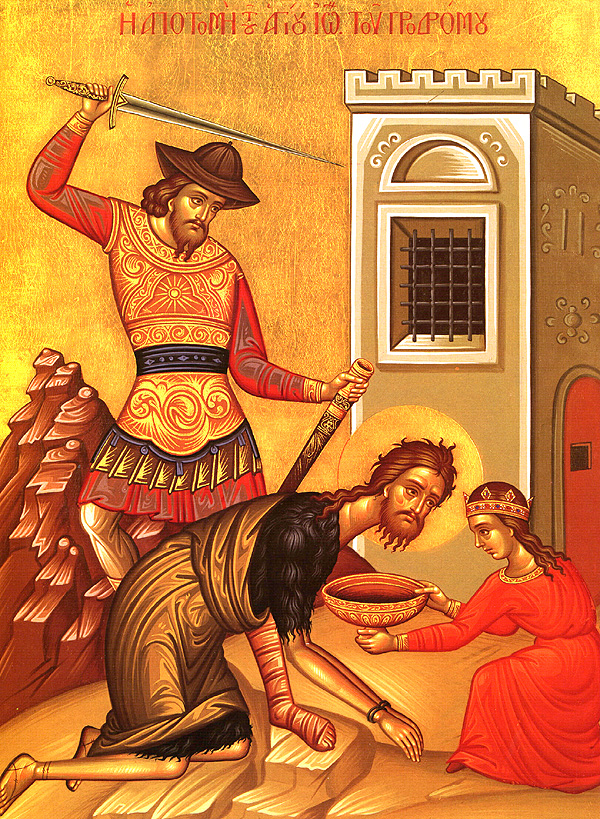 The Beheading of the Prophet, Forerunner of the Lord, John the Baptist: The Evangelists Matthew (Mt.14:1-12) and Mark (Mark 6:14-29) provide accounts about the martyric end of John the Baptist in the year 32 after the Birth of Christ.
The Beheading of the Prophet, Forerunner of the Lord, John the Baptist: The Evangelists Matthew (Mt.14:1-12) and Mark (Mark 6:14-29) provide accounts about the martyric end of John the Baptist in the year 32 after the Birth of Christ.
Following the Baptism of the Lord, Saint John the Baptist was locked up in prison by Herod Antipas, the Tetrarch (ruler of one fourth of the Holy Land) and governor of Galilee. (After the death of king Herod the Great, the Romans divided the territory of Palestine into four parts, and put a governor in charge of each part. Herod Antipas received Galilee from the emperor Augustus).


